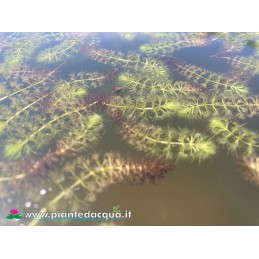- New







Submerged plant, rare, the shipped portion consists of 5 stems.
Plant native to Siberia.
Aldrovanda vesiculosa, commonly known as the waterwheel plant, is the only living species in the flowering plant genus Aldrovanda of the family Droseraceae. This aquatic plant captures small aquatic invertebrates using traps similar to those of the Venus flytrap.
The traps are arranged in whorls around a freely floating central stem, hence the common name. Aldrovanda is one of the few plant species capable of rapid movements. Morphologically, it consists of floating stems that reach a length of 6-40 cm. Trap leaves measuring 2-3 mm grow in whorls of 5-9 along the central stem of the plant. The actual traps are supported by stalks containing air sacs that aid in buoyancy.
 Politiche per la sicurezza
Politiche per la sicurezza
(modificale nel modulo Rassicurazioni cliente)
 Politiche per le spedizioni
Politiche per le spedizioni
(modificale nel modulo Rassicurazioni cliente)
Aldrovanda vesiculosa, commonly known as the waterwheel plant, is the only living species in the flowering plant genus Aldrovanda of the family Droseraceae. This aquatic plant captures small aquatic invertebrates using traps similar to those of the Venus flytrap.
The traps are arranged in whorls around a freely floating central stem, hence the common name. Aldrovanda is one of the few plant species capable of rapid movements. Morphologically, it consists of floating stems that reach a length of 6-40 cm. Trap leaves measuring 2-3 mm grow in whorls of 5-9 along the central stem of the plant. The actual traps are supported by stalks containing air sacs that aid in buoyancy.
One part of the stem grows continuously while the other part dies off. Growth is quite rapid (4-9 mm per day in Japanese populations), resulting in the production of a new whorl once or more daily under optimal conditions. The actual traps consist of two lobes that snap shut to form a smaller underwater snap trap similar to that of the Venus flytrap, but more compact and situated underwater.
These traps, twisted so that the openings point outward, are internally lined with a thin layer of sensitive hairs that close in response to contact with trapped aquatic invertebrates. Aldrovanda vesiculosa occurs in Europe, Africa, Asia, and Australia. However, there are potentially invasive populations in the eastern United States. The species is declining, with only 50 confirmed existing populations worldwide.
Carnivorous plant enthusiasts often cultivate it. In summary, Aldrovanda vesiculosa is a rootless aquatic plant that captures invertebrates using traps similar to those of the Venus flytrap. It is a rare and valuable specimen to conserve.
Your review appreciation cannot be sent
Report comment
Report sent
Your report cannot be sent
Write your review
Review sent
Your review cannot be sent

Submerged plant, rare, the shipped portion consists of 5 stems.
Plant native to Siberia.
Aldrovanda vesiculosa, commonly known as the waterwheel plant, is the only living species in the flowering plant genus Aldrovanda of the family Droseraceae. This aquatic plant captures small aquatic invertebrates using traps similar to those of the Venus flytrap.
The traps are arranged in whorls around a freely floating central stem, hence the common name. Aldrovanda is one of the few plant species capable of rapid movements. Morphologically, it consists of floating stems that reach a length of 6-40 cm. Trap leaves measuring 2-3 mm grow in whorls of 5-9 along the central stem of the plant. The actual traps are supported by stalks containing air sacs that aid in buoyancy.